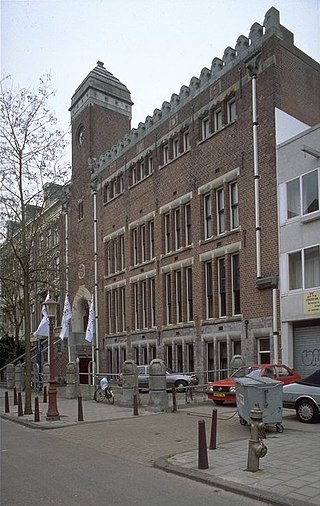Related Research Articles

The General Diamond Workers' Union of the Netherlands was a trade union for diamond workers in the Netherlands from 1894 to the 1920s.
The Printing and Paper Union was a trade union representing people in the printing and papermaking industries in the Netherlands.
The General Dutch Printing Union was a trade union representing workers in the printing industry in the Netherlands.
The General Dutch Union of the Building and Wood Industries was a trade union representing workers in the construction and wood industries in the Netherlands.

The General Dutch Construction Union was a trade union representing workers in the construction industry in the Netherlands.

The General Dutch Metalworkers' Union was a trade union representing workers in the metal industry in the Netherlands.
General Union of Miscellaneous Industries was a general union in the Netherlands, focusing on manufacturing industries.

The General Industrial Union of Textiles and Clothing, also known as De Eendracht, was a trade union representing workers in the textile and garment industries in the Netherlands.
The General Industrial Union of Furniture Makers and Woodworkers was a trade union representing workers involved in making things with wood in the Netherlands.
The General Dutch Industrial Union of Agriculture was a trade union representing workers in the agricultural sector in the Netherlands.
The General Dutch Union of Domestic Workers was a trade union representing domestic workers in the Netherlands.
The General Dutch Typographers' Union was an early trade union, representing typographers in the Netherlands.
The Dutch Painters' Assistants' Union was a trade union representing workers in the painting and decorating trade in the Netherlands.
The Dutch Transport Workers' Union was a trade union representing workers in the transport industry in the Netherlands.
The Dutch Catholic Printing Union was a trade union representing workers in the printing industry in the Netherlands.
The General Dutch Association for Trade and Office Clerks and Travelling Salesmen (Dutch: Algemene Nederlandse Bond voor Handels- en Kantoorbedienden en Handelsreizigers, often known as Mercurius, was a trade union representing white collar workers in the Netherlands.
The General Union of Civil Servants was a trade union representing civil servants, including postal and telecommunication workers, in the Netherlands.
The Central Dutch Union of Civil Servants was a trade union representing administrative civil servants in the Netherlands.

The Dutch Union of Personnel in Government Service was a trade union representing blue collar government workers in the Netherlands.

The General Union of Education Personnel was a trade union representing workers in the education sector in the Netherlands.
References
- ↑ "Archief Algemene Nederlandse Grafische Bond". International Institute of Social History. Retrieved 8 October 2020.
- ↑ "Internationale Addressen" (PDF). Graphische Presse. 28 January 1921. Retrieved 2 June 2020.
- ↑ "Grijze literatuur". Sociaal Historisch Centrum voor Limburg. Retrieved 21 October 2020.
- ↑ "Archief Algemene Nederlandse Grafische Bond". Archives Portal Europe. Retrieved 8 October 2020.